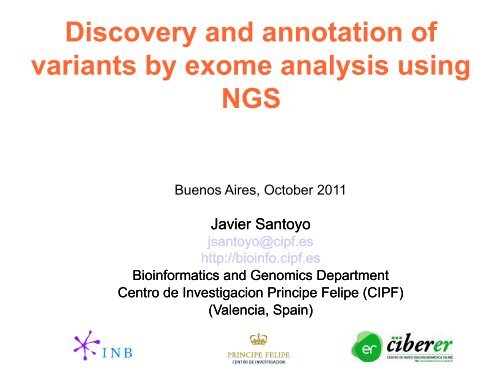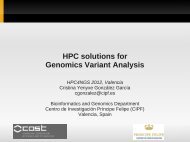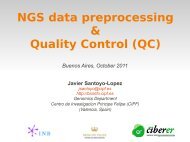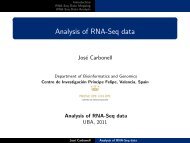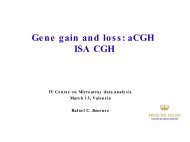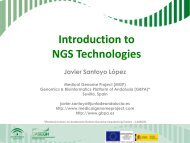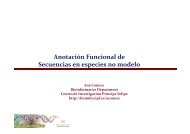Discovery and annotation of variants by exome analysis using NGS
Discovery and annotation of variants by exome analysis using NGS
Discovery and annotation of variants by exome analysis using NGS
You also want an ePaper? Increase the reach of your titles
YUMPU automatically turns print PDFs into web optimized ePapers that Google loves.
<strong>Discovery</strong> <strong>and</strong> <strong>annotation</strong> <strong>of</strong><br />
<strong>variants</strong> <strong>by</strong> <strong>exome</strong> <strong>analysis</strong> <strong>using</strong><br />
<strong>NGS</strong><br />
Buenos Aires, October 2011<br />
Javier Santoyo<br />
jsantoyo@cipf.es<br />
http://bioinfo.cipf.es<br />
Bioinformatics <strong>and</strong> Genomics Department<br />
Centro de Investigacion Principe Felipe (CIPF)<br />
(Valencia, Spain)
Some <strong>of</strong> the most common<br />
applications <strong>of</strong> <strong>NGS</strong>.<br />
Many array-based technologies become obsolete !!!<br />
RNA-seq<br />
Transcriptomics:<br />
Quantitative<br />
Descriptive<br />
(alternative<br />
splicing)<br />
miRNA<br />
Resequencing:<br />
SNV <strong>and</strong> indel<br />
Structural<br />
variation (CNV,<br />
translocations,<br />
inversions, etc.)<br />
Chip-seq<br />
Protein-DNA interactions<br />
Active transcription factor<br />
binding sites, etc.<br />
De novo<br />
sequencing<br />
Metagenomics<br />
Metatranscriptomics
Evolution <strong>of</strong> the papers published in<br />
microarray <strong>and</strong> next gen technologies<br />
Source Pubmed. Query: "high-throughput sequencing"[Title/Abstract] OR "next<br />
generation sequencing"[Title/Abstract] OR "rna seq"[Title/Abstract]) AND<br />
year[Publication Date]<br />
Projections 2011 based on January <strong>and</strong> February
Next generation sequencing<br />
technologies are here<br />
100,000<br />
10,000<br />
First genome:<br />
13 years<br />
~3,000,000,000€<br />
Milion €<br />
1,000<br />
100<br />
10<br />
1<br />
0.1<br />
0.01<br />
Moore’s<br />
Law<br />
Sequence to Variation Workflow<br />
Raw<br />
Data<br />
FastQ<br />
FastX<br />
Tookit<br />
FastQ<br />
IGV<br />
BWA/<br />
BWASW<br />
SAM<br />
BWA/<br />
BWASW<br />
SAM<br />
Tools<br />
GFF<br />
Filter<br />
VCF<br />
BCF<br />
Tools<br />
Raw<br />
VCF<br />
BCF<br />
Tools<br />
Pileup<br />
Samtools<br />
mPileup<br />
BAM
Raw Sequence Data Format<br />
• Fasta, csfasta<br />
• Fastq, csfastq<br />
• SFF<br />
• SRF<br />
• The eXtensible SeQuence (XSQ)<br />
• Others:<br />
– http://en.wikipedia.org/wiki/List_<strong>of</strong>_file_formats#Biology
Fasta & Fastq formats<br />
• FastA format<br />
– Header line starts with “>” followed <strong>by</strong> a sequence ID<br />
– Sequence (string <strong>of</strong> nt).<br />
• FastQ format<br />
– First is the sequence (like Fasta but starting with “@”)<br />
– Then “+” <strong>and</strong> sequence ID (optional) <strong>and</strong> in the following line<br />
are QVs encoded as single <strong>by</strong>te ASCII codes<br />
• Nearly all aligners take FastA or FastQ as input sequence<br />
• Files are flat files <strong>and</strong> are big
Processed Data Formats<br />
• Column separated file format contains features<br />
<strong>and</strong> their chromosomal location. There are flat<br />
files (no compact)<br />
– GFF <strong>and</strong> GTF<br />
– BED<br />
– WIG<br />
• Similar but compact formats <strong>and</strong> they can h<strong>and</strong>le<br />
larger files<br />
– BigBED<br />
– BigWIG
Processed Data Formats GFF<br />
• Column separated file format contains features<br />
located at chromosomal locations<br />
• Not a compact format<br />
• Several versions<br />
– GFF 3 most currently used<br />
– GFF 2.5 is also called GTF (used at Ensembl for<br />
describing gene features)
GFF structure<br />
GFF3 can describes the representation <strong>of</strong> a protein-coding gene
GFF3 file example<br />
##gff-version 3<br />
##sequence-region ctg123 1 1497228<br />
ctg123 . gene<br />
1000 9000 . + . ID=gene00001;Name=EDEN<br />
ctg123 . TF_binding_site 1000 1012 . + . Parent=gene00001<br />
ctg123 . mRNA<br />
1050 9000 . + . ID=mRNA00001;Parent=gene00001<br />
ctg123 . mRNA<br />
1050 9000 . + . ID=mRNA00002;Parent=gene00001<br />
ctg123 . mRNA<br />
1300 9000 . + . ID=mRNA00003;Parent=gene00001<br />
ctg123 . exon<br />
1300 1500 . + . Parent=mRNA00003<br />
ctg123 . exon<br />
1050 1500 . + . Parent=mRNA00001,mRNA00002<br />
ctg123 . exon<br />
3000 3902 . + . Parent=mRNA00001,mRNA00003<br />
ctg123 . exon<br />
5000 5500 . + . Parent=mRNA00001,mRNA00002,mRNA00003<br />
ctg123 . exon<br />
7000 9000 . + . Parent=mRNA00001,mRNA00002,mRNA00003<br />
ctg123 . CDS<br />
1201 1500 . + 0 ID=cds00001;Parent=mRNA00001<br />
ctg123 . CDS<br />
3000 3902 . + 0 ID=cds00001;Parent=mRNA00001<br />
ctg123 . CDS<br />
5000 5500 . + 0 ID=cds00001;Parent=mRNA00001<br />
ctg123 . CDS<br />
7000 7600 . + 0 ID=cds00001;Parent=mRNA00001<br />
ctg123 . CDS<br />
1201 1500 . + 0 ID=cds00002;Parent=mRNA00002<br />
ctg123 . CDS<br />
5000 5500 . + 0 ID=cds00002;Parent=mRNA00002<br />
ctg123 . CDS<br />
7000 7600 . + 0 ID=cds00002;Parent=mRNA00002<br />
ctg123 . CDS<br />
3301 3902 . + 0 ID=cds00003;Parent=mRNA00003<br />
ctg123 . CDS<br />
5000 5500 . + 2 ID=cds00003;Parent=mRNA00003<br />
ctg123 . CDS<br />
7000 7600 . + 2 ID=cds00003;Parent=mRNA00003<br />
ctg123 . CDS<br />
3391 3902 . + 0 ID=cds00004;Parent=mRNA00003<br />
ctg123 . CDS<br />
5000 5500 . + 2 ID=cds00004;Parent=mRNA00003<br />
ctg123 . CDS<br />
7000 7600 . + 2 ID=cds00004;Parent=mRNA00003<br />
Column 1: "seqid"<br />
Column 2: "source"<br />
Column 3: "type"<br />
Column 4: "start"<br />
Column 5: "end"<br />
Column 6: "score"<br />
Column 7: "str<strong>and</strong>"<br />
Column 8: "phase"<br />
Column 9: "attributes"
BED<br />
• Created <strong>by</strong> USCS genome team<br />
• Contains similar information to the GFF, but<br />
optimized for viewing in the UCSC genome browser<br />
• BIG BED, optimized for next gen data – essentially<br />
a binary version<br />
– It can be displayed at USCS Web browser (even several<br />
Gbs !!)
WIG<br />
• Also created <strong>by</strong> USCS team<br />
• Optimized for storing “levels”<br />
• Useful for displaying “peaks” (transcriptome, ChIPseq)<br />
• BIG WIG is a binary WIG format<br />
• It can also be uploaded onto USCS web browser
Short Read Aligners, just a few<br />
AGiLE<br />
BFAST<br />
BLASTN<br />
BLAT<br />
Bowtie<br />
BWA<br />
CASHX<br />
CUDA-EC<br />
ELAND<br />
GNUMAP<br />
GMAP <strong>and</strong> GSNAP<br />
Geneious Assembler<br />
LAST<br />
MAQ<br />
MOM<br />
MOSAIK<br />
Novoalign<br />
PALMapper<br />
PerM<br />
QPalma<br />
RazerS<br />
RMAP<br />
SeqMap<br />
Shrec<br />
SHRiMP<br />
SLIDER<br />
SLIM Search<br />
SOAP <strong>and</strong> SOAP2<br />
SOCS<br />
SSAHA <strong>and</strong> SSAHA2<br />
Stampy<br />
Taipan<br />
UGENE<br />
XpressAlign<br />
ZOOM<br />
...<br />
Adapted from http://en.wikipedia.org/wiki/List_<strong>of</strong>_sequence_alignment_s<strong>of</strong>tware
Mapped Data: SAM specification<br />
This specification aims to define a generic sequence alignment format, SAM,<br />
that describes the alignment <strong>of</strong> query sequencing reads to a reference<br />
sequence or assembly, <strong>and</strong>:<br />
• Is flexible enough to store all the alignment information generated <strong>by</strong> various<br />
alignment programs;<br />
• Is simple enough to be easily generated <strong>by</strong> alignment programs or converted<br />
from existing alignment formats;<br />
• SAM specification was developed for the 1000 Genome Project.<br />
– Contains information about the alignment <strong>of</strong> a read to a genome <strong>and</strong><br />
keeps track <strong>of</strong> chromosomal position, quality alignment, <strong>and</strong> features <strong>of</strong><br />
the alignment (extended cigar).<br />
• Includes mate pair / paired end information joining distinct reads<br />
• Quality <strong>of</strong> alignment denoted <strong>by</strong> mapping/pairing QV<br />
Li H.*, H<strong>and</strong>saker B.*, Wysoker A., Fennell T., Ruan J., Homer N., Marth G., Abecasis G., Durbin R. <strong>and</strong> 1000 Genome Project Data<br />
Processing Subgroup (2009) The Sequence alignment/map (SAM) format <strong>and</strong> SAMtools. Bioinformatics, 25, 2078-9. [PMID: 19505943]
Mapped Data: SAM/BAM format<br />
●<br />
SAM (Sequence Alignment/Map) developed to keep track <strong>of</strong><br />
chromosomal position, quality alignments <strong>and</strong> features <strong>of</strong> sequence<br />
reads alignment.<br />
• BAM is a binary version <strong>of</strong> SAM - This format is more compact<br />
• Most <strong>of</strong> downstream <strong>analysis</strong> programs takes this binary format<br />
• Allows most <strong>of</strong> operations on the alignment to work on a stream<br />
without loading the whole alignment into memory<br />
• Allows the file to be indexed <strong>by</strong> genomic position to efficiently<br />
retrieve all reads aligning to a locus.<br />
Li H.*, H<strong>and</strong>saker B.*, Wysoker A., Fennell T., Ruan J., Homer N., Marth G., Abecasis G., Durbin R. <strong>and</strong> 1000 Genome Project Data<br />
Processing Subgroup (2009) The Sequence alignment/map (SAM) format <strong>and</strong> SAMtools. Bioinformatics, 25, 2078-9. [PMID: 19505943]
BAM format<br />
• Many tertiary <strong>analysis</strong> tools use BAM<br />
– BAM makes machine specific issues “transparent” e.g.<br />
colour space<br />
– A common format makes downstream <strong>analysis</strong><br />
independent from the mapping program<br />
IGV http://www.broadinstitute.org/igv<br />
SAVANT Fiume et al<br />
Adapted from http://www.bioinformatics.ca/files/CBW%20-%20presentations/HTSeq_2010_Module%202/HTSeq_2010_Module%202.pdf
SAM format
SAM format
VCF format<br />
- The Variant Call Format (VCF) is the emerging st<strong>and</strong>ard for<br />
storing variant data.<br />
- Originally designed for SNPs <strong>and</strong> short INDELs, it also works for<br />
structural variations.<br />
- VCF consists <strong>of</strong> a header section <strong>and</strong> a data section.<br />
- The header must contain a line starting with one '#', showing<br />
the name <strong>of</strong> each field, <strong>and</strong> then the sample names starting at<br />
the 10th column.<br />
- The data section is TAB delimited with each line consisting <strong>of</strong><br />
at least 8 m<strong>and</strong>atory fields<br />
The FORMAT field <strong>and</strong> sample information are allowed to be<br />
absent.<br />
http://samtools.sourceforge.net/mpileup.shtml
VCF data section fields<br />
http://samtools.sourceforge.net/mpileup.shtml
The Draft Human Genome Sequence millestone<br />
DISEASE<br />
METABOLOME<br />
PROTEOME<br />
TRANSCRIPTOME<br />
GENOME
Some diseases are coded in the<br />
genome<br />
How to find mutations associated to diseases<br />
An equivalent <strong>of</strong> the genome would amount<br />
almost 2000 books, containing 1.5 million letters<br />
each (average books with 200 pages).<br />
This information is contained in any single cell <strong>of</strong><br />
the body.
In monogenic diseases only one<br />
mutation causes the disease.<br />
T<br />
Example:<br />
Book 1129, pag. 163, 3 rd<br />
paragraph, 5 th line, 27 th letter<br />
should be a A instead a T<br />
The challenge is to find<br />
this letter changed out <strong>of</strong><br />
all the 3000 millions <strong>of</strong><br />
letters in the 2000 books<br />
<strong>of</strong> the library<br />
Solution:<br />
Read it all<br />
Problem:<br />
Too much to read
The bioinfomatic challenge: finding the<br />
mutation that causes the disease.<br />
The problem is even worst: we cannot read the library<br />
complete library.<br />
Sequencers can only read small portions. No more than<br />
500 letters at a time.<br />
So, the library<br />
must be inferred<br />
from fragments<br />
<strong>of</strong> pages <strong>of</strong> the<br />
books<br />
ATCCACTGG<br />
CCCCTCGTA<br />
GCGAAAAGC
Reading the text<br />
En un lugar de la Mancha, de cuyo nombre no quiero acordarme…<br />
En un lugar de la Mancha, de cuyo nombre no quiero acordarme…<br />
En un lugar de la Mancha, de cuyo nombre ni quiero acordarme…<br />
En un lugar de la Mancha, de cuyo nombre ni quiero acordarme…<br />
En u | n lugar d | e la Manc | ha, de c | uyo no | mbre no qu | iero acor | darme<br />
En un lu | gar de la M | ancha, de c | uyo nom |<br />
bre no q | uiero aco | rdarme<br />
En | un luga | r de la Ma | ncha, de cu | yo nombr | e ni quie | ro acordar | me<br />
En un lu | gar de la Man | cha, d | e cuyo n | ombre n | i quier | o acorda | rme
Mapping fragments <strong>and</strong> detection <strong>of</strong><br />
mutations<br />
yo nombr<br />
un lugar de la Mancha, de cu ombre n darme<br />
gar de la Man e cuyo n e ni quie o acorda<br />
En n lugar d ancha, de cuyo nom uiero aco me<br />
En u gar de la M ha, de c bre no q iero acor rme<br />
En un lu e la Manc mbre no qu ro acordar<br />
En un lugar de la M cha, d uyo no i quier rdarme<br />
En un lugar de la Mancha, de cuyo nombre no quiero acordarme
Space reduction: Look only for<br />
Mutations that can affect transcription <strong>and</strong>/or gene<br />
products<br />
Triplex-forming<br />
sequences<br />
(Goñi et al. Nucleic Acids<br />
Res.32:354-60, 2004)<br />
Human-mouse<br />
conserved regions<br />
Amino acid<br />
change<br />
Splicing inhibitors<br />
SF2/ASF<br />
SC35<br />
Transfac<br />
TFBSs<br />
SRp40<br />
SRp55<br />
(Wingender et al., Nucleic<br />
Acids Res., 2000)<br />
Intron/exon junctions<br />
(Cartegni et al., Nature Rev. Genet., 2002)<br />
ESE (exonic splicing<br />
enhancers) motifs<br />
recognized <strong>by</strong> SR<br />
proteins<br />
(Cartegni et al., Nucleic Acids Res., 2003)
Why <strong>exome</strong> sequencing<br />
• Whole-genome sequencing <strong>of</strong> individual humans is increasingly practical . But cost remains a key<br />
consideration <strong>and</strong> added value <strong>of</strong> intergenic mutations is not cost-effective.<br />
●<br />
Alternative approach: targeted resequencing <strong>of</strong> all protein-coding subsequences (<strong>exome</strong><br />
sequencing, ~1% <strong>of</strong> human genome)<br />
• Linkage <strong>analysis</strong>/positional cloning studies that focused on protein coding sequences were highly<br />
successful at identification <strong>of</strong> <strong>variants</strong> underlying monogenic diseases (when adequately powered)<br />
• Known allelic <strong>variants</strong> known to underlie Mendelian disorders disrupt protein-coding sequences<br />
●<br />
Large fraction <strong>of</strong> rare non-synonymous <strong>variants</strong> in human genome are predicted to be deleterious<br />
• Splice acceptor <strong>and</strong> donor sites are also enriched for highly functional variation <strong>and</strong> are therefore<br />
targeted as well<br />
The <strong>exome</strong> represents a highly enriched subset <strong>of</strong> the genome in which to<br />
search for <strong>variants</strong> with large effect sizes
How does <strong>exome</strong> sequencing work<br />
Gene A<br />
Gene B<br />
1<br />
Produce shotgun<br />
library<br />
DNA (patient)<br />
2<br />
Capture exon<br />
sequences<br />
4<br />
Map against<br />
reference genome<br />
5<br />
Determine<br />
<strong>variants</strong>,<br />
Filter, compare<br />
patients<br />
3<br />
c<strong>and</strong>idate genes<br />
Wash & Sequence
Exome sequencing<br />
Common Research Goals<br />
Identify novel genes responsible for monogenic diseases<br />
Use the results <strong>of</strong> genetic research to discover new drugs acting on<br />
new targets (new genes associated with human disease pathways)<br />
Identify susceptibility genes for common diseases<br />
Challenges<br />
To develop innovative bioinformatics tools for the detection <strong>and</strong><br />
characterisation <strong>of</strong> mutations <strong>using</strong> genomic information.
Rare <strong>and</strong> common disorders<br />
Exome sequencing<br />
Manolio TA, et al (2009). Finding the missing heritability <strong>of</strong> complex diseases. Nature., 461(7265), 747
Finding mutations associated to<br />
diseases<br />
The simplest case: dominant monogenic disease<br />
A<br />
B<br />
C<br />
Controls<br />
D<br />
E<br />
Cases
The principle: comparison <strong>of</strong> patients<br />
<strong>and</strong> reference controls<br />
mutation<br />
Patient 1<br />
Patient 2<br />
Patient 3<br />
Control 1<br />
Control 2<br />
Control 3<br />
c<strong>and</strong>idate gene (shares mutation for all patients but no controls)
Different levels <strong>of</strong> complexity<br />
• Diseases can be dominant or recessive<br />
• Diseases can have incomplete penetrancy<br />
• Patients can be sporadic or familiar<br />
• Controls can or cannot be available<br />
A<br />
B<br />
Dominant: (hetero in B, C <strong>and</strong> D) AND (no in A<br />
<strong>and</strong> E) AND no in controls<br />
Recessive: (homo in B, C <strong>and</strong> D) hetero in A<br />
<strong>and</strong> D AND NO homo in controls<br />
C D E<br />
Ad-hoc strategies are needed for the <strong>analysis</strong>
Filtering<br />
Strategies<br />
Reducing the number <strong>of</strong><br />
c<strong>and</strong>idate genes in two<br />
directions<br />
Share Genes with<br />
variations<br />
Patient<br />
1<br />
Patient 2 Patient 3<br />
Several shared Genes<br />
No filtering<br />
genes with<br />
variant<br />
genes with<br />
variant<br />
genes with<br />
variant<br />
Remove<br />
known<br />
<strong>variants</strong><br />
genes with<br />
variant<br />
genes with<br />
variant<br />
genes with<br />
variant<br />
Remove<br />
synonymou<br />
s <strong>variants</strong><br />
genes with<br />
variant<br />
genes with<br />
variant<br />
genes with<br />
variant<br />
...<br />
Few shared Genes
An example with MTC<br />
A<br />
D<br />
B<br />
C<br />
Dominant:<br />
Heterozygotic in A <strong>and</strong> D<br />
Homozygotic reference allele in B <strong>and</strong> C<br />
Homozygotic reference allele in controls<br />
A<br />
RET, codon<br />
634 mutation<br />
D<br />
B<br />
C
The Pursuit <strong>of</strong> Better <strong>and</strong> more Efficient Healthcare<br />
as well as Clinical Innovation through Genetic <strong>and</strong><br />
Genomic Research<br />
Public-Private partnership<br />
Autonomous Government <strong>of</strong> Andalusia<br />
Spanish Ministry <strong>of</strong> Innovation<br />
Pharma <strong>and</strong> Biotech Companies
MGP Specific objectives<br />
To sequence the genomes <strong>of</strong> clinically well characterized patients<br />
with potential mutations in novel genes.<br />
To generate <strong>and</strong> validate a database <strong>of</strong> genomes <strong>of</strong> phenotyped<br />
control individuals.<br />
To develop bioinformatics tools for the detection <strong>and</strong><br />
characterisation <strong>of</strong> mutations
SAMPLES + UPDATED AND COMPREHENSIVE HEALTH RECORD<br />
Currently14,000 Phenotyped DNA Samples<br />
from patients <strong>and</strong> control individuals.<br />
Prospective Healthcare:<br />
linking research & genomic<br />
information to health record<br />
databases<br />
Patient health & sample record real<br />
time automatic update <strong>and</strong><br />
comprehensive data mining system<br />
SIDCA Bio B<br />
e-Bank<br />
Andalusian DNA Bank
Direct link to the health care system<br />
MPG roadmap is based on the availability <strong>of</strong> >14.000 wellcharacterized<br />
samples with a permanent updated sample<br />
information & PHR that will be used as the first steps <strong>of</strong> the<br />
implementation <strong>of</strong> personalized medicine in the Andalusian HCS<br />
•Cancer<br />
• Unknown genes<br />
•Congenital anomalies<br />
(heart, gut, CNS,…)<br />
•Mental retardation<br />
•MCA/MR syndromes<br />
• Known genes discarded<br />
• Responsible genes<br />
known but unknown<br />
modifier genes<br />
>14.000<br />
phenotyped<br />
samples<br />
•Diabetes<br />
•Neurodegenerative<br />
diseases<br />
with<br />
•Susceptibility Genes<br />
• …<br />
•Stroke (familiar)<br />
•Endometriosis<br />
•Control Individuals
Two technologies to scan for<br />
variations<br />
454 Roche<br />
Longer reads<br />
Lower coverage<br />
Structural<br />
variation<br />
•Amplifications<br />
•Deletions<br />
•CNV<br />
•Inversions<br />
•Translocations<br />
SOLiD ABI<br />
Shorter reads<br />
Higher coverage<br />
Variants<br />
•SNPs<br />
•Mutations<br />
•indels
Analysis Pipeline<br />
Raw Data Quality Control QC<br />
FastQC & in house s<strong>of</strong>tware<br />
Reads Mapping & QC<br />
Variant Calling<br />
BWA, Bowtie, BFAST<br />
QC in house s<strong>of</strong>tware<br />
GATK, SAMTOOLS, FreeBayes<br />
Bioscope<br />
Variant Filtering<br />
dbSNP, 1000 Genomes<br />
Variant <strong>annotation</strong><br />
Annovar & in house s<strong>of</strong>tware<br />
Disease/Control comparison<br />
Family & healthy controls
Approach to discovery rare or novel<br />
<strong>variants</strong><br />
130.00<br />
0<br />
99.000<br />
55.000<br />
18.000.000
Timeline <strong>of</strong> the MGP<br />
Now 2011 2012 …<br />
• First 50<br />
genomes<br />
• First 2-3<br />
diseases<br />
• Several hundreds <strong>of</strong><br />
genomes<br />
• 100 diseases (approx)<br />
Yet unpredictable<br />
number <strong>of</strong><br />
genomes <strong>and</strong><br />
diseases<br />
Announced<br />
changes in<br />
the<br />
technology<br />
Expected<br />
changes in<br />
the<br />
technology
Nimblegen capture arrays<br />
●<br />
SeqCap EZ Human Exome Library v1.0 / v2.0<br />
●<br />
Gene <strong>and</strong> exon <strong>annotation</strong>s (v2.0):<br />
●<br />
RefSeq (Jan 2010), CCDS (Sept 2009), miRBase (v.14, Sept 2009).<br />
●<br />
Total <strong>of</strong> ~30,000 coding genes (theoretically)<br />
●<br />
●<br />
~300,000 exons;<br />
36.5 Mb are targeted <strong>by</strong> the design.<br />
●<br />
2.1 million long oligo probes to cover the target regions.<br />
●<br />
Because some flanking regions are also covered <strong>by</strong> probes, the total size <strong>of</strong> regions covered <strong>by</strong> probes is<br />
44.1 Mb<br />
●<br />
Real coverage:<br />
– Coding genes included: 18897<br />
– miRNAs 720<br />
– Coding genes not captured: 3865
Sequencing at MGP<br />
By the end <strong>of</strong> June<br />
2011 there are 72<br />
<strong>exome</strong>s sequenced<br />
so far.<br />
4 SOLiD can produce<br />
20 <strong>exome</strong>s per week<br />
The facilities <strong>of</strong> the<br />
CASEGH can carry<br />
out the MGP <strong>and</strong><br />
other collaborative<br />
projects at the same<br />
time
Real coverage <strong>and</strong> some figures<br />
Sequencing<br />
Enrichment +Sequence run: ~2 weeks<br />
400,000,000 sequences/flowcell<br />
20,000,000,000 bases/flowcell<br />
Short 50bp sequences<br />
Exome Coverage<br />
SeqCap EZ Human Exome Library v1.0 / v2.0<br />
Total <strong>of</strong> ~30,000 coding genes (theoretically)<br />
~300,000 exons;<br />
36.5 Mb are targeted <strong>by</strong> the design (2.1 million long oligo<br />
probes).<br />
Real coverage:<br />
Coding genes included: 18,897<br />
miRNAs 720<br />
Coding genes not captured: 3,865<br />
Genes <strong>of</strong> the <strong>exome</strong> with coverage >10x: 85%
Data Simulation & <strong>analysis</strong><br />
●<br />
Data simulated for 80K mutations <strong>and</strong> 60x coverage<br />
• BWA finds less false positives in simulated data
Real Data & <strong>analysis</strong><br />
●<br />
Analiysis data is compared to genotyped data<br />
●<br />
BFAST higher number <strong>of</strong> <strong>variants</strong> <strong>and</strong> 95% agreement
And this is what we find in the<br />
variant calling pipeline<br />
Coverage > 50x<br />
Variants (SNV): 60.000 – 80.000<br />
Variants (indels): 600-1000<br />
100 known <strong>variants</strong> associated to disease risk
From data to knowledge<br />
Some considerations<br />
Obvious: huge datasets need to be<br />
managed <strong>by</strong> computers<br />
Important: bioinformatics is<br />
necessary to properly analyze the<br />
data.<br />
Even more important <strong>and</strong> not so<br />
obvious: hypotheses must be tested<br />
from the perspective provided <strong>by</strong> the<br />
bioinformatics<br />
The science is generated where the data reside.<br />
Yesterday’s “one-bite” experiments fit into a laboratory notebook. Today, terabite<br />
data from genomic experiments reside in computers, the new scientist’s notebook
And It gets more complicated<br />
Context <strong>and</strong> cooperation between genes cannot be ignored<br />
Controls<br />
Cases<br />
The cases <strong>of</strong> the multifactorial disease will have different<br />
mutations (or combinations). Many cases have to be used<br />
to obtain significant associations to many markers. The<br />
only common element is the pathway (yet unknow)<br />
affected.
The Bioinformatics <strong>and</strong> Genomics Department at the Centro de<br />
Investigación Príncipe Felipe (CIPF), Valencia, Spain, <strong>and</strong>…<br />
Joaquín Dopazo<br />
Eva Alloza<br />
Roberto Alonso<br />
Alicia Amadoz<br />
Davide Baù<br />
Jose Carbonell<br />
Ana Conesa<br />
Alej<strong>and</strong>ro de Maria<br />
Hernán Dopazo<br />
Pablo Escobar<br />
Fern<strong>and</strong>o García<br />
Francisco García<br />
Luz García<br />
Stefan Goetz<br />
Carles Llacer<br />
Martina Marbà<br />
Marc Martí<br />
Ignacio Medina<br />
David Montaner<br />
Luis Pulido<br />
Rubén Sánchez<br />
Javier Santoyo<br />
Patricia Sebastian<br />
François Serra<br />
Sonia Tarazona<br />
Joaquín Tárraga<br />
Enrique Vidal<br />
Adriana Cucchi<br />
...the INB, National Institute <strong>of</strong> Bioinformatics (Functional<br />
Genomics Node) <strong>and</strong> the CIBERER Network <strong>of</strong> Centers for Rare<br />
Diseases
CASEGH<br />
Área de Genómica<br />
Dr. Alicia Vela Boza<br />
Dr. S<strong>and</strong>ra Pérez Buira<br />
María Sánchez León<br />
Javier Escalante Martín<br />
Ana Isabel López Pérez<br />
Beatriz Fuente Bermúdez<br />
Área Bioinformática<br />
Daniel Navarro Gómez<br />
Pablo Arce García<br />
Luis Miguel Cruz<br />
Secretaría/Administración<br />
Inmaculada Guillén Baena<br />
HOSPITAL UNIVERSITARIO VIRGEN DEL ROCÍO<br />
Dr. Macarena Ruiz Ferrer<br />
Nerea Matamala Zamarro<br />
Pr<strong>of</strong>. Guillermo Antiñolo Gil<br />
Director de la UGC de Genética, Reproducción y Medicina<br />
Fetal Director del Plan de Genética de Andalucía<br />
CABIMER<br />
Director de CABIMER y del Departamento de Terapia<br />
Celular y Medicina Regenerativa<br />
Pr<strong>of</strong>. Shom Shanker Bhattacharya,<br />
CENTRO DE INVESTIGACIÓN PRÍNCIPE FELIPE<br />
Responsable de la Unidad de Bioinformática y Genómica y<br />
Director científico asociado para Bioinformática del Plan de<br />
Genética de Andalucía<br />
Dr. Joaquín Dopazo Blázquez



